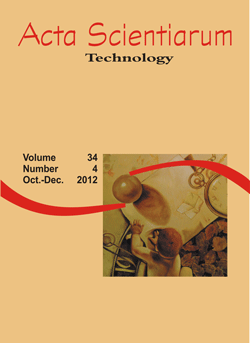<b>Development of cassava cake enriched with its own bran and <i>Spirulina platensis</i></b> - doi: 10.4025/actascitechnol.v34i4.10687
DOI:
https://doi.org/10.4025/actascitechnol.v34i4.10687Palavras-chave:
bakery products, single cell protein, manioc, nutritional enrichment, sensorial acceptanceResumo
The cassava cake was developed enriching it with a biomass of Spirulina platensis and a type of bran made out of its own starch. This biomass, a part from being rich in protein, also contains vitamins, essential fatty acids and minerals. Around Umuarama, in the State of Paraná, there is an agricultural/industrial complex annually producing and processing tons of cassava. Baked goods can be elaborated based in cassava as a way to expand the use of this raw material and to produce food free of gluten to celiac people. In this complex a solid byproduct is generated, which is rich in starch and fibres, and because of its low commercial value it is used for animal feed or discarded. The bran was dehydrated and analysed microbiologically as well as physically and chemically so as to be used in applied research. Developed energetic food based on cassava lacks protein, but this can be supplied by adding the biomass of Spirulina platensis. Different formulations of this cassava cake were developed varying the concentration of Spirulina platensis and cassava bran. The formulation that presented the best features received chocolate before being submitted to sensory tests by children in the public education system. The results show an excellent acceptance which made viable the development of this product because of aspects like nutrition, technology and sensorial.
Downloads
Downloads
Publicado
Como Citar
Edição
Seção
Licença
DECLARAÇíO DE ORIGINALIDADE E DIREITOS AUTORAIS
Declaro que o presente artigo é original, não tendo sido submetido í publicação em qualquer outro periódico nacional ou internacional, quer seja em parte ou em sua totalidade.
Os direitos autorais pertencem exclusivamente aos autores. Os direitos de licenciamento utilizados pelo periódico é a licença Creative Commons Attribution 4.0 (CC BY 4.0): são permitidos o compartilhamento (cópia e distribuição do material em qualqer meio ou formato) e adaptação (remix, transformação e criação de material a partir do conteúdo assim licenciado para quaisquer fins, inclusive comerciais.
Recomenda-se a leitura desse link para maiores informações sobre o tema: fornecimento de créditos e referências de forma correta, entre outros detalhes cruciais para uso adequado do material licenciado.















